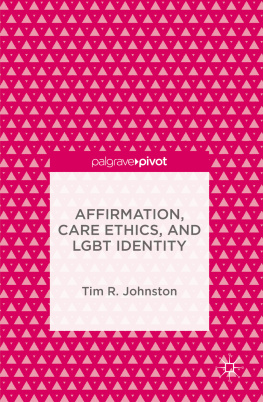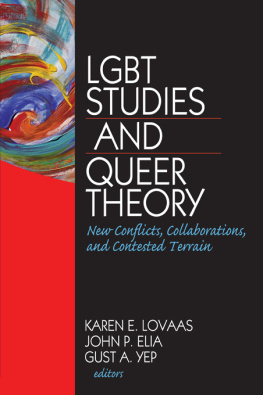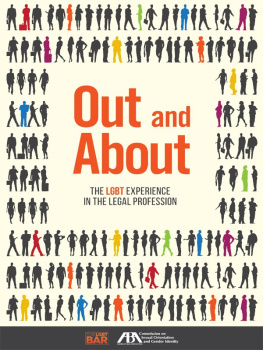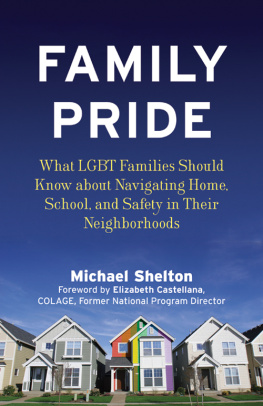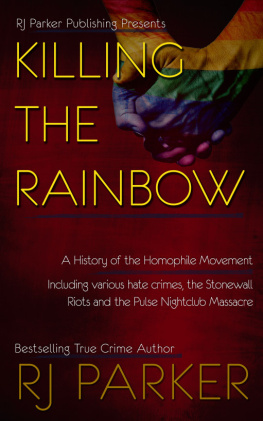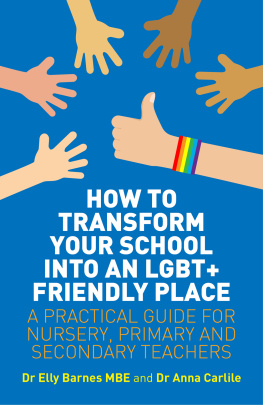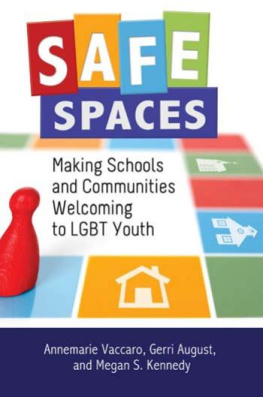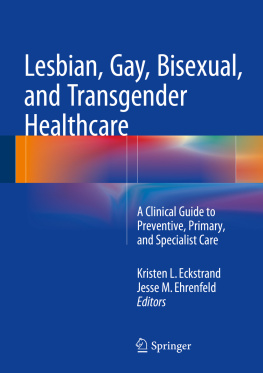1. Introduction: The Need for Affirming Spaces
AMY GOODMAN: What advice do you giveI mean, these figures you give around suicide are just horrifyingfor young people? What advice do you give to them?
LAVERNE COX: I mean, well, the statistic, 41 percent of trans folks have attempted suicide. Im one of those trans people. I think we need to begin to create loving spaces where we affirm peoples gender identity and expression, so that people can belive in a space of gender self-determination without stigma and without shame, and know that peoplefor people to know that theyre loved no matter who they are and how they identify.
Democracy Now! interview with Laverne Cox, CeCe McDonald, and Alisa Williams 2/19/2014
Over the past several years, people identified as lesbian, gay, bisexual, and transgender (LGBT) have made great advances in securing certain legal rights and protections. Marriage equality, the repeal of Dont Ask, Dont Tell, local antibullying initiatives, and antidiscrimination legislation have all been heralded as successes for the LGBT movement. Yet, LGBT people are still routinely psychologically and physically assaultedwith recent media attention drawn to the connection between school bullying, cyber bullying, and LGBT teen suicideand LGBT older adults often receive substandard care and face systemic abuse in long-term care facilities. These facts underline the importance of Laverne Coxs call to create loving spaces where we affirm peoples gender identity and, I would add, sexual orientation. The LGBT community has created many subcultural spaces where we affirm one another, but we still are not affirmed, and often not welcome at all, in the shared spaces of public life. If we want to improve LGBT peoples quality of life we need to ask whether and why LGBT people experience places like schools, dormitories, hospitals, senior centers, parks, shopping malls, public transportation, and government offices as comfortable or threatening. Are these places where we can be open and move fluidly, or do these places demand hiding LGBT identities? Shifting these important public and shared spaces from being hostile to being affirming can be a daunting task. What makes this shift possible? What can activists and allies do to create affirming spaces?
This book provides a theoretical analysis and the practical tools LGBT people and their allies need to work toward making all spaces, public and private, spaces in which we can live and move freely. Using a combination of philosophical analysis, ethical argument, and real-world examples, I show that affirmation is a form of care that both stabilizes our identities and constitutes our embodied relationship to physical spaces. When we think of affirmation we might think of a pat on the back, a pleasant bit of feedback, or a warm and heartfelt You can do it! While these are certainly forms of affirmation, my use of affirmation is not limited to interpersonal encouragement. I understand an affirmation as anything that reflects part of my identity back to me. It can be verbal (a loved one affirms my sexual orientation), physical (a family photograph affirms my membership in a family), or cultural (a character in a television show reflects and affirms an aspect of my identity). Affirmations can be positive or negative, intentional or unintentional, and performed by conscious agents or fulfilled by inanimate objects. In the chapters that follow I demonstrate that affirmation is more than a psychological phenomenon or act of dispensing encouragement or a compliment; it is how we come to have a sense of self, how that self or identity changes across time, and how it relates to different physical environments. Legal protections and rights are important, but if we want to have a tangible and immediate positive impact on the LGBT community we have to also focus on creating spaces where LGBT people feel affirmed and at home.
Affirmation impacts everyone at every stage of life. Given the concepts wide-ranging applicability, I have chosen to focus on two case studies that bear on several different public spaces and different moments in the life span: bullying among young adults and abuse faced by LGBT older adults. The first case study articulates the importance of affirmation in the development of a stable and healthy identity in the school system and other spaces important to adolescent development, while the second allows me to describe the role of affirmation at the end of life and in aging network services, such as senior centers and long-term care and assisted-living facilities.
My decision to write about LGBT bullying is grounded in my own experience of being bullied. I was one of several students routinely bullied for several years of elementary school. I have vivid memories of daily verbal harassment and physical injury. Despite the fact that I loved my teachers and enjoyed learning, I quickly became withdrawn, began lashing out at my younger sister, experienced regular stomach pain and nausea, and started exhibiting signs of obsessivecompulsive behavior. I can still feel the dread of entering my classroom, the anxiety of leaving my home, and the fear of seeing the bullies. The classroom environment became so toxic that several families removed their children from the school, and I was one of a handful of students whose parents decided to try home schooling.
I quickly became a happy and healthy kid once I was removed from this school and placed in an environment filled with positive affirmations of my identity and worth. I have thought a lot about this shift from a toxic to safe environment, and I noticed the same pattern many years later when I came out as a gay man. Coming out was a long process of pruning away the relationships and affirmations that denied or devalued my gayness and cultivating relationships and environments that affirmed my sexual orientation. This is a long and often difficult process; I was out for years before I could fully claim my gay identity.
These issues are not unique to LGBT people. We have all experienced being seen or ignored, affirmed as worthy of love or as worthless. What has always stuck with me is the impact that these experiences have not only on our psyche, but also on our embodiment. When I was bullied I stooped and felt nauseous all the time. When I was closeted, my sexual desires, and by extension my body, constantly threatened to reveal my secret. I policed my mannerisms and denied my own athletic ability for fear that a tiny slipup, a single limp wrist or jump of excitement, would out me to my peers. By contrast, when I feel loved and affirmed as valuable, that feeling I think of as being at home, my embodiment is easy, fluid, and comfortable. Because so much of affirmation extends beyond the strictly psychological into our somatic experience, my touchstone for whether or not something is positively or negatively affirming is if it makes our embodied movement in a given space more fluid or more stilted. If a space is affirming of my identity, I will experience that place as one in which I can be myself and move fluidly. By contrast, if a place is not affirming or negatively affirming, I will be vigilant, stilted, and fearful.

